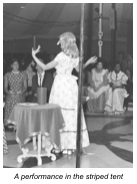
In 1966, North Central College started a community theatre tradition. Enthusiastic drama students appealed to professor Don Shanower for opportunities beyond the school year. Shanower enlisted the help of part-time faculty member Don Jamison and together they launched Summer Place Theatre.
Jamison’s career was at Western Electric Co. but he also founded amateur drama clubs and appeared in live WMAQ-TV productions. Teacher Shanower worked with student John Belushi at NCC and cast him in "A Thousand Clowns" in 1969, but Belushi was fired from his during rehearsals for chronic absenteeism.
 Shanower got permission to use a storefront on Washington and Porter that once housed a Chevy dealer and SPT performed five shows that first season.
Shanower got permission to use a storefront on Washington and Porter that once housed a Chevy dealer and SPT performed five shows that first season.
For the next several years, productions were held under tents that were erected on the NCC campus. Torrential rainstorms in 1969 and again in 1973 destroyed the tents, as well as the shows being performed there.
Around the same time, the barn where props were stored was burned to the ground, but SPT still didn’t give up.
 A metal-roofed pavilion was built to replace the tent. Unfortunately, it was soon crushed by the Great Blizzard of 1979, but a second pavilion lasted for a decade. For many years, SPT hoped to raise enough money to erect a permanent home, but shows instead have been held at North Central High School.
A metal-roofed pavilion was built to replace the tent. Unfortunately, it was soon crushed by the Great Blizzard of 1979, but a second pavilion lasted for a decade. For many years, SPT hoped to raise enough money to erect a permanent home, but shows instead have been held at North Central High School. Competition is fierce today for people’s time and it’s hard to find both volunteers to prepare the shows and an audience to watch them, but tough little Summer Place Theatre is already looking forward to the next 50 years. See summerplacetheatre.org to learn more about this season’s shows.














